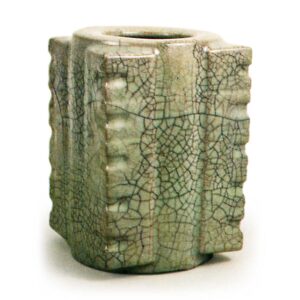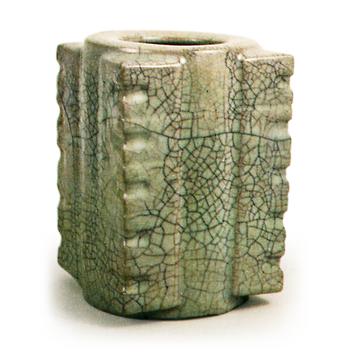
This kiln was an official kiln of the late Southern Song dynasty in China, and is located under the Suburban kiln of the Southern Song dynasty, 16 kilometers outside of Jiamen in Hangzhou. It is therefore also called “Xin Guan Kiln under the Suburban Kiln. The kiln site was probably first pointed out by Perio, who wrote in his article “Xiannu Lin’an Zhi” in the “Shuppo” newspaper in 1923: “The blueware kilns are located on either side of the round platform on the top of Xiongwuying Mountain. The site of the Suburban Kiln is located at the western foot of Wugui Mountain, and this small mountain is said to be the remains of the Suburban Kiln and still has a stepped shape. The nature of the Suburban Kiln is now almost clear from the shards recovered from the kiln site. The clay is azure-gray in color and sometimes has a slightly pale yellow tinge. The clay of the exposed body, for example, is almost always black. The underglaze is also black, and when looking at the fracture surface, black fine lines can often be seen under the glaze both inside and outside. There is a theory that this black color, especially underglaze black, is due to oxidation caused by air entering through the cracks in the ice or by air, but this is highly doubtful. In order to detect the purple-gouged iron foot from the Gue kiln, an iron-rich clay or glaze may have been applied over the body. The glaze is a beautiful and lustrous blue-green color with large ice cracks and shading, which is particularly pleasing to the eye. In addition, the glaze surface is smooth and shiny. Thin wares are the norm. However, some of them seem to have a yellowish-brown tinge to the glaze. There is a theory that these are from the Gue kiln, but it is doubtful. It is unknown when the Shunaiji kiln, an official kiln in the early Southern Song period, was moved to the suburban area, or when the last firing took place there. It is assumed, however, that thorough excavation has been conducted in present-day China. The National Palace Museum in Taipei has a remarkable collection of artifacts from the Xiaotan kiln, while in Japan, the Tokyo National Museum has a wagoda bowl (Yokogawa Collection) and a jar (donated by Hirota Fukkosai).
Saki truly flourished.)



